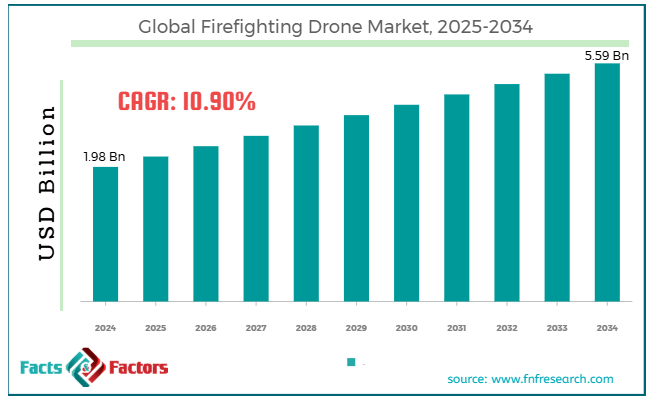Search Market Research Report
Firefighting Drone Market Size, Share Global Analysis Report, 2025 – 2034

Firefighting Drone Market Size, Share, Growth Analysis Report By Applications (Firefighting, Disaster Assessment, Search And Rescue, Scene Monitoring, And Others), By Propulsion Types (Solar-Powered, Piston Engine, And Electric Motors), By Sizes (Macro And Micro Drones), And By Region - Global Industry Insights, Overview, Comprehensive Analysis, Trends, Statistical Research, Market Intelligence, Historical Data and Forecast 2025 – 2034
Industry Insights
[221+ Pages Report] According to Facts & Factors, the global firefighting drone market size was valued at USD 1.98 billion in 2024 and is predicted to surpass USD 5.59 billion by the end of 2034. The firefighting drone industry is expected to grow by a CAGR of 10.90% between 2025 and 2034.

 Market Overview
Market Overview
Firefighting drones are a kind of unmanned aerial vehicle that helps users in firefighting operations. These drones can effectively suppress wildfires by offering surveillance, aerial support, and active suppression capabilities. These drones are well-equipped with payload mechanisms to drop fire suppression balls, fire retardants, and water.
Moreover, it helps in search and rescue missions. It also identifies individuals trapped in the smoky, dark, or debris-filled areas. It is a highly helpful option in post-incident assessment, allowing for thorough investigation of the case afterwards.
 Key Insights
Key Insights
- As per the analysis shared by our research analyst, the global firefighting drone market size is estimated to grow annually at a CAGR of around 10.90% over the forecast period (2025-2034).
- In terms of revenue, the global firefighting drone market size was valued at around USD 1.98 billion in 2024 and is projected to reach USD 5.59 billion by 2034.
- Integration of AI and IoT is driving the growth of the global firefighting drone market.
- Based on the applications, the firefighting segment is growing at a high rate and is projected to dominate the global market.
- Based on propulsion types, the electric motors segment is anticipated to grow with the highest CAGR in the global market.
- Based on the sizes, the macro drones segment is projected to swipe the largest market share.
- Based on region, North America is expected to dominate the global market during the forecast period.
 Growth Drivers
Growth Drivers
- Integration of AI and IoT is likely to drive the growth of the global market.
Firefighting drones are well-equipped with AI and IoT capabilities, which easily help users process data in real-time for better decision-making. Moreover, it facilitates accurate predictive analytics to check for the area where the wildfire is active. It also helps to coordinate with ground teams so that authorities can make an ideal disaster management plan.
However, advancements in thermal imaging and sensor technology are expected to revolutionize the market further. The sensor technologies help detect wildfire hotspots even with negligible visibility. These help identify and rescue the trapped individual.
Therefore, these factors are anticipated to boost the growth of the global firefighting drone market. For instance, NASA and the Federal Aviation Administration (FAA) announced that they would establish a research transition team to develop innovative technology for wildfire management in 2024. The major goal of this partnership is to improve the airspace management system.
 Restraints
Restraints
- High initial investments are likely to hinder the growth of the global market.
The drones are expensive, making it difficult to scale the industry's growth. Modern firefighting drones are equipped with fire-retardant delivery systems, thermal imaging, and AI navigation, which further add to the overall costs. Apart from the acquisition cost, the maintenance and repair costs also negatively affect the growth trajectory of the firefighting drone industry.
 Opportunities
Opportunities
- Ongoing investments are likely to foster growth opportunities in the global market.
The growing interest of venture capitalists in UAV and fire tech start-ups is expected to accelerate the growth of the global firefighting drone market. Also, government funding to develop innovative solutions like AI-based drones is likely to positively influence the growth trajectory. The market is witnessing numerous start-ups specializing in battery technology innovations and autonomous firefighting UAVs, which is expected to expand the market's scope in the coming years.
Also, the growing adoption of hybrid and hydrogen-based drones for longer missions and larger payloads is expected to foster numerous growth opportunities in the industry. The increasing use of these solutions in post-fire assessment and recovery is further likely to contribute to the significant rise of the market. These innovations help users carry out missions in large forest fires and disaster-prone regions.
The ongoing integration with smart city infrastructure further makes these drones inevitable. These drones are in high use beyond emergency response, and therefore, they are highly integrated into the smart city ecosystem, which helps users automatically function in case of fire detection.
For instance, in 2023, the Kerala Fire and Rescue Services successfully took over drones to strengthen their firefighting capabilities for UAV deployment.
 Challenges
Challenges
- Lack of skilled operators is a big challenge in the global market.
Many regions do not have skilled staff and personnel to operate these advanced drones, which is emerging as a big challenge in the firefighting drone industry. However, data privacy concerns and cybersecurity breaches are expected to limit the growth of the market.
 Report Scope
Report Scope
Report Attribute |
Details |
Market Size in 2024 |
USD 1.98 Billion |
Projected Market Size in 2034 |
USD 5.59 Billion |
CAGR Growth Rate |
10.90% CAGR |
Base Year |
2024 |
Forecast Years |
2025-2034 |
Key Market Players |
Lockheed Martin Corporation, Draganfly Inc., Elbit Systems Ltd., Yuneec, AeroVironment Inc., Parrot SA, DJI, Aerialtronics DV B.V., BSS Holland B.V., and others. |
Key Segment |
By Applications, By Propulsion Types, By Sizes, and Region |
Major Regions Covered |
North America, Europe, Asia Pacific, Latin America, and the Middle East &, Africa |
Purchase Options |
Request customized purchase options to meet your research needs. Explore purchase options |
 Segmentation Analysis
Segmentation Analysis
The global firefighting drone market can be segmented into applications, propulsion types, sizes, and regions.
On the basis of applications, the market can be segmented into firefighting, disaster assessment, search and rescue, scene monitoring, and others. The firefighting segment is expected to account for the largest share of the firefighting drone industry during the forecast period. Climate change is emerging as a key reason leading to more frequent wildfires, thereby facilitating the segment's growth.
However, the traditional firefighting techniques were not enough to handle the entire situation, and therefore, there is a rising demand for drone-based services. New drones are capable of being used as water payloads. Moreover, these drones are well-integrated with the auto-targeting technique, which is further likely to reduce human risk.
On the basis of propulsion types, the market can be segmented into solar-powered, piston engine, and electric motor. Electric motors are the fastest-growing segment in the global firefighting drone market during the forecast period. Electric drones do not emit any gases into the environment; therefore, they are ideal for climate-conscious operations. It helps end-users with global decarbonization, a major reason, and is gaining user attraction.
Additionally, these engines have lower operating costs than piston engines and require less maintenance. Moreover, these facilitate quieter operations, which further help in rescue missions and monitoring potential disturbances. Additionally, the innovation of polymer-based batteries is also driving the growth of the segment due to their enhanced power efficiency and longer lifetime.
On the basis of sizes, the market can be segmented into macro and micro drones. The macro drones are leading the firefighting drone industry during the anticipated period. These have higher capacities, which is ideal for detecting fire applications. These drones can be well-equipped with CO2 canisters, fire retardants, thermal sensors, and many others, which help in achieving missions effectively. These can operate for longer operational times with a greater coverage area, which makes it the best option, particularly for managing wildfires in remote and large areas.
These macro drones have advanced capabilities that make them better than other options. It includes AI object recognition, autonomous navigation, thermal imaging, and live video transmission, which is very helpful in hazardous environments, as manned aircraft are unsafe. These are also widely used in different inland security for fire suppression and disaster response.
On the basis of types, the market can be segmented into multirotor and fixed wings. The multirotor segment is projected to emerge as the most lucrative segment in the global firefighting drone market during the forecast period. Multi-rotors have high maneuverability and therefore help them hover a vehicle in any direction. These are lightweight, compact, and can be deployed quickly. It is also versatile in nature and can be used for a wide range of activities like spotting fire hotspots, dropping extinguishing agents, monitoring hazardous zones, real-time thermal imaging, rescue missions, and others.
Drones also have lower cost and require less maintenance, which makes them attractive for municipal departments. They help them easily carry out emergency services, which is expected to revolutionize the market in the coming years.
 Regional Analysis
Regional Analysis
- North America is expected to dominate the global market.
North America accounts for the largest share of the global firefighting drone market during the forecast period. The US is the leading country in the regional market because it experiences numerous wildfires annually. Countries like the Pacific Northwest, Texas, and California are among the regions that frequently experience wildfires.
Therefore, the region has a high demand for advanced firefighting tech. Government support and funding are likely to further propel the regional market's growth. The North American region is home to giant companies like Lockheed Martin, which is anticipated to positively influence the market in the coming years. Canada is also a leading region because of the frequent wildfires in Yukon, Alberta, and British Columbia.
Additionally, the Canadian government is strongly focused on adopting eco-friendly technologies. The government is also investing in a drone fleet, which can help manage wildfires and best serve the remote and Arctic areas to deal with inaccessible wildfires.
Asia Pacific is emerging as a major region likely to see significant growth in the coming years. Countries like India, China, and Australia are witnessing frequent wildfire incidents because of increasing deforestation and climate change. Moreover, the limitations of conventional firefighting tools are also contributing to the strengthening of demand for advanced firefighting solutions in the APAC region.
Japan is also investing heavily in disaster preparedness to enhance its disaster response strategy and utilize advanced tools to combat wildfires in the region. Growing urbanization and industrialization in APAC are propelling the risk of fire incidence, which is likely to pave a positive growth path for the regional market.
APAC is a densely populated area that is further promoting the use of drones and investment in R&D to improve the firefighting capabilities of the region. Technological advancements like the integration of AI, thermal imaging, and real-time data analytics in firefighting drones are likely to improve the response capabilities and help the government monitor hotspots and fires in real time.
Therefore, all these factors are expected to foster growth opportunities in the regional market in the coming years. For instance, the Robotics Institute at Carnegie Mellon University initiated a project in 2024 to develop drones for fighting wildfires, which can cover acres of land.
 Competitive Analysis
Competitive Analysis
The key players in the global firefighting drone market include:
- Lockheed Martin Corporation
- Draganfly Inc.
- Elbit Systems Ltd.
- Yuneec
- AeroVironment Inc.
- Parrot SA
- DJI
- Aerialtronics DV B.V.
- BSS Holland B.V.
For instance, DJI came up with the New Matrice 350 RTK in 2024. It is an aircraft equipped with advanced capabilities for public safety applications, such as firefighting. It responds better to fires and has payload capacities to hold specialized firefighting equipment.
The global firefighting drone market is segmented as follows:
 By Applications Segment Analysis
By Applications Segment Analysis
- Firefighting
- Disaster Assessment
- Search And Rescue
- Scene Monitoring
- Others
 By Propulsion Types Segment Analysis
By Propulsion Types Segment Analysis
- Solar-Powered
- Piston Engine
- Electric Motors
 By Sizes Segment Analysis
By Sizes Segment Analysis
- Macro Drones
- Micro Drones
 By Regional Segment Analysis
By Regional Segment Analysis
- North America
- The U.S.
- Canada
- Mexico
- Europe
- France
- The UK
- Spain
- Germany
- Italy
- Rest of Europe
- Asia Pacific
- China
- Japan
- India
- Australia
- Southeast Asia
- Rest of Asia Pacific
- The Middle East & Africa
- Saudi Arabia
- UAE
- Egypt
- Kuwait
- South Africa
- Rest of the Middle East & Africa
- Latin America
- Brazil
- Argentina
- Rest of Latin America
Industry Major Market Players
- Lockheed Martin Corporation
- Draganfly Inc.
- Elbit Systems Ltd.
- Yuneec
- AeroVironment Inc.
- Parrot SA
- DJI
- Aerialtronics DV B.V.
- BSS Holland B.V.
Frequently Asked Questions

Copyright © 2024 - 2025, All Rights Reserved, Facts and Factors


